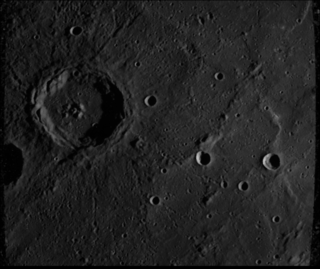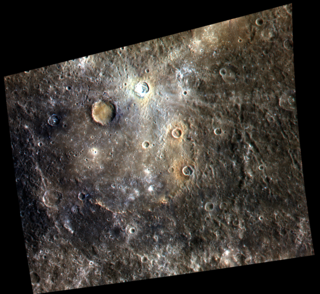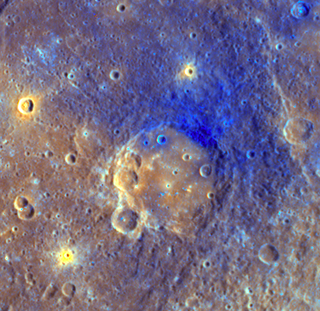
Zola is a crater on Mercury. The crater was named after the French novelist and playwright Émile Zola by the IAU in 1979.

Arecibo Catena is a catena on Mercury. It is named after Arecibo Observatory, the former large radio telescope in Puerto Rico.

Bach is a double-ringed impact basin within the Bach quadrangle of Mercury. It was named by the IAU in 1976.

Matisse is an impact crater on the southern hemisphere of Mercury. Matisse takes its name from the French artist Henri Matisse, and it was named by the IAU in 1976.

Raphael is a crater on Mercury. Its name was adopted by the International Astronomical Union (IAU) in 1976, and is named for the Italian painter Raphael. It is Tolstojan in age. The crater was first imaged by Mariner 10 in 1974.

Homer is a crater on Mercury. It is one of 110 peak ring basins on Mercury. It is Tolstojan in age.

Praxiteles is a crater on Mercury. It is one of 110 peak ring basins on Mercury.

Titian is an impact crater on the planet Mercury. It was named by the IAU in 1976.

Raden Saleh is a crater on Mercury. Its name was approved by the IAU in 2008, and it is named after a famous Indonesian painter named Raden Saleh.

Calvino is a crater on Mercury. Its name was adopted by the IAU in 2016, after the Italian writer Italo Calvino.

Dominici is a crater on Mercury. It was named by the IAU in 2010.

Picasso is a crater on Mercury. It has drawn scientific attention because of the large, arc-shaped pit crater located on the eastern side of its floor. Similar pits have been discovered on the floors of several other Mercury craters, such as Beckett, Glinka, and Gibran. These pits are postulated to have formed when subsurface magma subsided or drained, causing the surface to collapse into the resulting void. If this interpretation is correct, pit-floor craters such as Picasso provide evidence of shallow magmatic activity in Mercury's history.

Leopardi is a crater on Mercury. Its name was adopted by the International Astronomical Union in 1976. Leopardi is named for the Italian writer Giacomo Leopardi, who lived from 1798 to 1837.

Mofolo is a crater on Mercury. Its name was adopted by the International Astronomical Union in 1976. Mofolo is named for the Basotho writer Thomas Mofolo, who lived from 1876 or 1877 to 1948.

Wagner is an impact crater in the south polar region of the planet Mercury. It was named after the German composer Richard Wagner (1813–1883) in 1976, as recognized by the International Astronomical Union. It is located in the Bach quadrangle, between Bach and Chopin.

Villa-Lobos is a crater on Mercury. Its name was adopted by the International Astronomical Union (IAU) on September 25, 2015. Villa-Lobos is named for the Brazilian composer Heitor Villa-Lobos.

Flaiano is a crater on Mercury. It has a diameter of 43 kilometres. Its name was adopted by the International Astronomical Union (IAU) on March 15, 2013. Flaiano is named for the Italian writer Ennio Flaiano. The crater was first imaged by Mariner 10 in 1974.


















